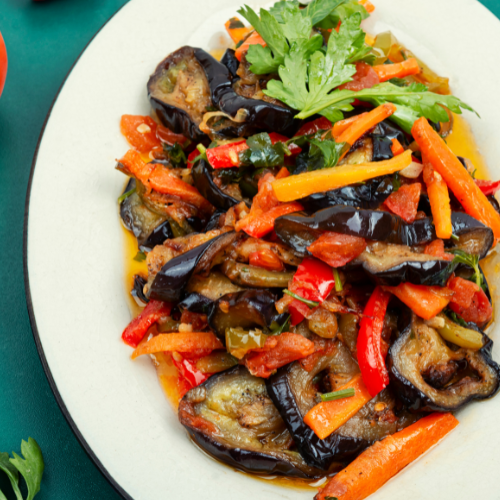Caponata Siciliana is more than just a dish; it is a vibrant representation of Sicilian culture, history, and the lush landscape of its Mediterranean origins. This eggplant dish, with its rich blend of flavors, has become a quintessential part of Italian cuisine, loved not only in Sicily but across the entire country. In this article, we delve deep into the origins, preparation, variations, and cultural significance of Caponata Siciliana, illustrating why it holds a special place in the hearts and kitchens of Italians.
Origins of Caponata Siciliana.
Caponata is a traditional Sicilian dish that traces its roots back to the 18th century. Its precise origins are somewhat murky, but many culinary historians believe it was influenced by the Arab occupation of Sicily, which lasted from the 9th to the 11th centuries. The Arabs introduced a variety of ingredients, including eggplant, capers, and nuts, which are now staples in Sicilian cooking. The name “caponata” itself is thought to derive from “capone,” a type of fish that was commonly used in the original recipes.As the dish evolved, it absorbed various influences, reflecting the diverse cultural tapestry of Sicily. Today, Caponata is typically made with eggplant as the main ingredient, combined with other vegetables such as tomatoes, celery, olives, and capers, all cooked in a sweet and sour sauce made of vinegar and sugar.
The Ingredients of Caponata Siciliana.
The beauty of Caponata lies in its colorful array of ingredients, each contributing to its unique flavor profile. Here are the essential components of this beloved dish:
- Eggplant (Melanzane): The star of the dish, eggplant, gives Caponata its hearty texture. It can be diced and sautéed until golden brown, providing a savory base for the other ingredients.
- Tomatoes: Fresh or canned tomatoes add acidity and sweetness, balancing the flavors of the dish.
- Celery: Chopped celery provides a crunchy texture and a refreshing note.
- Capers: These small flower buds add a briny flavor, enhancing the dish’s complexity.
- Olives: Green or black olives contribute a salty richness that complements the other ingredients.
- Vinegar: Typically red wine vinegar, it creates the signature sweet and sour taste that characterizes Caponata.
- Sugar: A small amount of sugar is added to balance the acidity of the vinegar.
- Pine Nuts: Optional, but they add a delightful crunch and a hint of sweetness.
Each of these ingredients plays a vital role in creating the harmonious blend of flavors that make Caponata Siciliana so special.
Preparation of Caponata Siciliana.
Preparing Caponata is both an art and a labor of love, requiring attention to detail and a passion for cooking. Here’s a step by step guide to making this classic dish:
Ingredients List:
- 2 large eggplants, diced
- 1 large onion, chopped
- 2-3 celery stalks, chopped
- 2 cups ripe tomatoes, diced (or one can of diced tomatoes)
- 1/2 cup green olives, pitted and sliced
- 2 tablespoons capers, rinsed
- 1/4 cup red wine vinegar
- 1-2 tablespoons sugar (to taste)
- 1/4 cup pine nuts (optional)
- Olive oil for sautéing
- Salt and pepper to taste
- Fresh basil for garnish
Instructions:
- Prepare the Eggplant: Sprinkle the diced eggplant with salt and let it sit for about 30 minutes to draw out excess moisture and bitterness. Rinse and pat dry.
- Sauté the Vegetables: In a large skillet, heat olive oil over medium heat. Add the chopped onion and sauté until translucent. Next, add the celery and cook until tender.
- Cook the Eggplant: Increase the heat and add the eggplant to the skillet. Sauté until golden brown, adding more oil if necessary.
- Add Tomatoes: Stir in the diced tomatoes and cook for about 10 minutes, allowing the mixture to thicken.
- Incorporate Other Ingredients: Add the olives, capers, vinegar, and sugar. Stir well and cook for an additional 5-10 minutes, allowing the flavors to meld. Taste and adjust seasoning with salt, pepper, and sugar as desired.
- Finish with Pine Nuts: If using, toast the pine nuts in a separate pan until golden and then fold them into the Caponata.
- Serve: Caponata can be served warm, at room temperature, or chilled. It is often garnished with fresh basil before serving.
Variations of Caponata.
While the classic recipe is beloved, there are numerous regional variations of Caponata throughout Sicily and beyond. Some popular adaptations include:
- Caponata Palermitana: This version is known for its sweeter flavor profile, often incorporating more sugar and sometimes raisins.
- Caponata Catanese: Hailing from Catania, this variation might include additional vegetables like zucchini and a richer sauce.
- Caponata with Fish: In some coastal areas, Caponata may include pieces of fish or seafood, adding a savory depth to the dish.
- Vegan Caponata: A naturally vegan dish, it can be made without any animal products, making it suitable for a wider audience.
- Caponata with Quinoa: A modern twist, this variation incorporates quinoa, adding protein and making it a heartier meal.

Cultural Significance.
Caponata Siciliana holds a significant place in Italian cuisine and culture. It is often served as an antipasto, a side dish, or even a main course, especially in vegetarian or vegan meals. The dish is a testament to the Sicilian philosophy of “cucina povera,” or “poor cooking,” which emphasizes using simple yet flavorful ingredients to create satisfying meals.Italians love Caponata not only for its taste but also for its versatility. It can be enjoyed at home, at family gatherings, or during festive occasions. Its ability to be served cold or warm makes it a perfect dish for any season, and its vibrant colors add a festive touch to any table.Moreover, Caponata reflects the Sicilian spirit of hospitality. Sharing food is a fundamental aspect of Italian culture, and Caponata is often made in large batches to be enjoyed with family and friends. Its communal nature encapsulates the warmth and generosity that Italians are known for.
Conclusion.
Caponata Siciliana is a dish that embodies the rich history, culture, and culinary traditions of Sicily. Its delightful combination of flavors and textures, along with its versatility, has made it a beloved staple both in Italy and around the world. Whether enjoyed as a starter, side, or main course, Caponata continues to be a cherished culinary treasure that brings people together, celebrating the joy of sharing good food.As you explore the world of Italian cuisine, make sure to include Caponata Siciliana in your culinary repertoire. Its delightful taste and history will surely impress your family and friends, making every meal an occasion to remember.Here check this quick and easy version of it below. Bona Patti!
Questions and Answers.
- What is Caponata Siciliana?
- Caponata Siciliana is a traditional Sicilian eggplant dish that combines a variety of vegetables in a sweet and sour sauce, often enjoyed as an antipasto or side dish.
- What are the main ingredients in Caponata?
- The main ingredients include eggplant, tomatoes, celery, olives, capers, vinegar, and sugar, along with optional pine nuts for added texture.
- Where does Caponata originate from?
- Caponata originates from Sicily, Italy, and reflects the island’s rich cultural influences, including Arab, Spanish, and Italian culinary traditions.
- Is Caponata a vegan dish?
- Yes, Caponata is naturally vegan and can be enjoyed by those following a plant based diet.
- How is Caponata typically served?
- Caponata can be served warm, at room temperature, or chilled. It is often enjoyed as an appetizer, side dish, or even as a main course in vegetarian meals.
